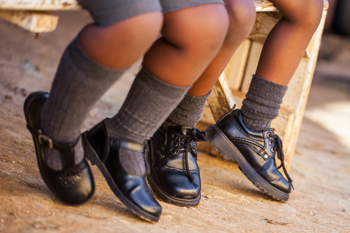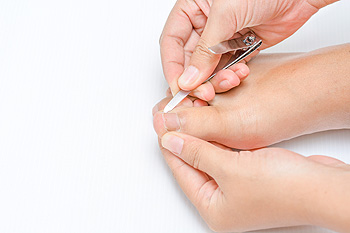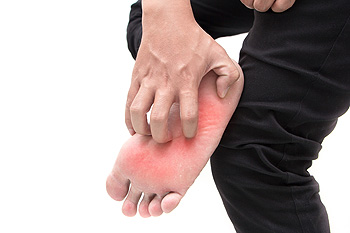Items filtered by date: May 2020
How Children’s Feet Can Become Stronger
 Research has indicated babies' feet can become stronger when the toes and feet can move without the restrictions of shoes. The foot muscles can become stronger when the child frequently kicks and wiggles their toes. As children begin to walk, wearing shoes while indoors is discouraged. When walking is done barefoot, the entire foot generally becomes stronger due to the toes grasping the floor. The average age children begin to walk is approximately twelve months. When the first pair of shoes is purchased, it is beneficial to ensure there is adequate room for the toes to move freely in. It is also recommended that your child’s feet are properly measured, as this can help to determine the correct size shoe. For additional information about children's feet and what shoes to purchase, it is suggested that you speak with a podiatrist.
Research has indicated babies' feet can become stronger when the toes and feet can move without the restrictions of shoes. The foot muscles can become stronger when the child frequently kicks and wiggles their toes. As children begin to walk, wearing shoes while indoors is discouraged. When walking is done barefoot, the entire foot generally becomes stronger due to the toes grasping the floor. The average age children begin to walk is approximately twelve months. When the first pair of shoes is purchased, it is beneficial to ensure there is adequate room for the toes to move freely in. It is also recommended that your child’s feet are properly measured, as this can help to determine the correct size shoe. For additional information about children's feet and what shoes to purchase, it is suggested that you speak with a podiatrist.
The health of a child’s feet is vital to their overall well-being. If you have any questions regarding foot health, contact Dr. Ronald Sheppard of Warren-Watchung Podiatry Center. Our doctor can provide the care you need to keep you pain-free and on your feet.
Tips for Keeping Children's Feet Healthy
- Make sure their shoes fit properly
- Look for any signs of in-toeing or out-toeing
- Check to see if they have Clubfoot (condition that affects your child’s foot and ankle, twisting the heel and toes inward) which is one of the most common nonmajor birth defects.
- Lightly cover your baby’s feet (Tight covers may keep your baby from moving their feet freely, and could prevent normal development)
- Allow your toddler to go shoeless (Shoes can be restricting for a young child’s foot)
- Cut toenails straight across to avoid ingrown toenails
- Keep your child’s foot clean and dry
- Cover cuts and scrapes. Wash any scratches with soap and water and cover them with a bandage until they’ve healed.
If you have any questions, please feel free to contact one of our offices located in Marlboro and Watchung, NJ . We offer the newest diagnostic and treatment technologies for all your foot care needs.
Practicing Foot Care May Help to Prevent Painful Conditions
 Research has indicated patients that maintain everyday foot care may be less likely to develop painful foot conditions. Twenty-five percent of the bones in the body are located in the feet, and it is beneficial to practice daily foot care which may help the feet to feel good. Wearing appropriate shoes while in public areas may help to prevent fungal infections from developing, which can include athlete’s foot and toenail fungus. Corns that can develop on the bottom of the foot or between the toes may be avoided when shoes are worn that fit properly. Additionally, this may help to avoid ingrown toenails from developing. A bony protrusion that develops on the side of the big toe is referred to as a bunion, and this may be prevented when the correct style shoes are worn. If you would like additional information about the importance of practicing everyday foot care, please consult with a podiatrist.
Research has indicated patients that maintain everyday foot care may be less likely to develop painful foot conditions. Twenty-five percent of the bones in the body are located in the feet, and it is beneficial to practice daily foot care which may help the feet to feel good. Wearing appropriate shoes while in public areas may help to prevent fungal infections from developing, which can include athlete’s foot and toenail fungus. Corns that can develop on the bottom of the foot or between the toes may be avoided when shoes are worn that fit properly. Additionally, this may help to avoid ingrown toenails from developing. A bony protrusion that develops on the side of the big toe is referred to as a bunion, and this may be prevented when the correct style shoes are worn. If you would like additional information about the importance of practicing everyday foot care, please consult with a podiatrist.
Everyday foot care is very important to prevent infection and other foot ailments. If you need your feet checked, contact Dr. Ronald Sheppard from Warren-Watchung Podiatry Center. Our doctor can provide the care you need to keep you pain-free and on your feet.
Everyday Foot Care
Often, people take care of their bodies, face and hair more so than they do for their feet. But the feet are a very important aspect of our bodies, and one that we should pay more attention to. Without our feet, we would not be able to perform most daily tasks.
It is best to check your feet regularly to make sure there are no new bruises or cuts that you may not have noticed before. For dry feet, moisturizer can easily be a remedy and can be applied as often as necessary to the affected areas. Wearing shoes that fit well can also help you maintain good foot health, as well as making it easier to walk and do daily activities without the stress or pain of ill-fitting shoes, high heels, or even flip flops. Wearing clean socks with closed shoes is important to ensure that sweat and bacteria do not accumulate within the shoe. Clean socks help to prevent Athlete’s foot, fungi problems, bad odors, and can absorb sweat.
If you have any questions please feel free to contact one of our offices located in Marlboro and Watchung, NJ . We offer the newest diagnostic and treatment technologies for all your foot and ankle needs.
How Did I Contract Athlete’s Foot?
 Skin that is red and peeling between the toes can be indicative of a condition that is known as athlete’s foot. It is a fungal infection, and is caused by fungus that lives and thrives in warm and moist environments. These can consist of public swimming pools, locker rooms, and communal showers. Additional symptoms may include severe itchiness, blisters, and the skin may become thick and cracked. Helpful prevention methods can involve wearing appropriate shoes while in these areas, followed by washing and drying the feet thoroughly. Athlete’s feet can cause pain and discomfort. If you think you are afflicted with this ailment, it is strongly suggested that you consult with a podiatrist who can prescribe the necessary medication for an effective treatment.
Skin that is red and peeling between the toes can be indicative of a condition that is known as athlete’s foot. It is a fungal infection, and is caused by fungus that lives and thrives in warm and moist environments. These can consist of public swimming pools, locker rooms, and communal showers. Additional symptoms may include severe itchiness, blisters, and the skin may become thick and cracked. Helpful prevention methods can involve wearing appropriate shoes while in these areas, followed by washing and drying the feet thoroughly. Athlete’s feet can cause pain and discomfort. If you think you are afflicted with this ailment, it is strongly suggested that you consult with a podiatrist who can prescribe the necessary medication for an effective treatment.
Athlete’s foot is an inconvenient condition that can be easily reduced with the proper treatment. If you have any concerns about your feet and ankles, contact Dr. Ronald Sheppard from Warren-Watchung Podiatry Center. Our doctor will treat your foot and ankle needs.
Athlete’s Foot: The Sole Story
Athlete's foot, also known as tinea pedis, can be an extremely contagious foot infection. It is commonly contracted in public changing areas and bathrooms, dormitory style living quarters, around locker rooms and public swimming pools, or anywhere your feet often come into contact with other people.
Solutions to Combat Athlete’s Foot
- Hydrate your feet by using lotion
- Exfoliate
- Buff off nails
- Use of anti-fungal products
- Examine your feet and visit your doctor if any suspicious blisters or cuts develop
Athlete’s foot can cause many irritating symptoms such as dry and flaking skin, itching, and redness. Some more severe symptoms can include bleeding and cracked skin, intense itching and burning, and even pain when walking. In the worst cases, Athlete’s foot can cause blistering as well. Speak to your podiatrist for a better understanding of the different causes of Athlete’s foot, as well as help in determining which treatment options are best for you.
If you have any questions please feel free to contact one of our offices located in Marlboro and Watchung, NJ . We offer the newest diagnostic and treatment technologies for all your foot and ankle needs.
Three Types of Corns
 The definition of a corn is a small hardened patch of skin on the sole of the foot that generally develops as a result of excess friction. The types of corns that form on the feet are categorized as either hard, soft, or seed. Hard is considered to be the most common type of corn, and can be found on top of the toes or on the bottom of the feet. Soft corns are typically found between the toes, and can cause pain and discomfort. The skin can become inflamed, and it may be difficult to wear shoes. Clogged sweat glands may produce seed corns, which can appear on the bottom of the feet. Most corns can be prevented by wearing shoes that fit correctly, in addition to trimming the toenails correctly. Mild relief can be found if a corn pad is worn, as this may provide a protection barrier for existing corns. If you have developed any type of corn, it is strongly suggested that you consult with a podiatrist who can help you to manage this condition.
The definition of a corn is a small hardened patch of skin on the sole of the foot that generally develops as a result of excess friction. The types of corns that form on the feet are categorized as either hard, soft, or seed. Hard is considered to be the most common type of corn, and can be found on top of the toes or on the bottom of the feet. Soft corns are typically found between the toes, and can cause pain and discomfort. The skin can become inflamed, and it may be difficult to wear shoes. Clogged sweat glands may produce seed corns, which can appear on the bottom of the feet. Most corns can be prevented by wearing shoes that fit correctly, in addition to trimming the toenails correctly. Mild relief can be found if a corn pad is worn, as this may provide a protection barrier for existing corns. If you have developed any type of corn, it is strongly suggested that you consult with a podiatrist who can help you to manage this condition.
If you have any concerns regarding your feet and ankles, contact Dr. Ronald Sheppard of Warren-Watchung Podiatry Center. Our doctor will treat your foot and ankle needs.
Corns: What Are They? and How Do You Get Rid of Them?
Corns can be described as areas of the skin that have thickened to the point of becoming painful or irritating. They are often layers and layers of the skin that have become dry and rough, and are normally smaller than calluses.
Ways to Prevent Corns
There are many ways to get rid of painful corns such as wearing:
- Well-fitting socks
- Comfortable shoes that are not tight around your foot
- Shoes that offer support
Treating Corns
Treatment of corns involves removing the dead skin that has built up in the specific area of the foot. Consult with Our doctor to determine the best treatment option for your case of corns.
If you have any questions please feel free to contact one of our offices located in Marlboro and Watchung, NJ . We offer the newest diagnostic and treatment technologies for all your foot and ankle needs.

